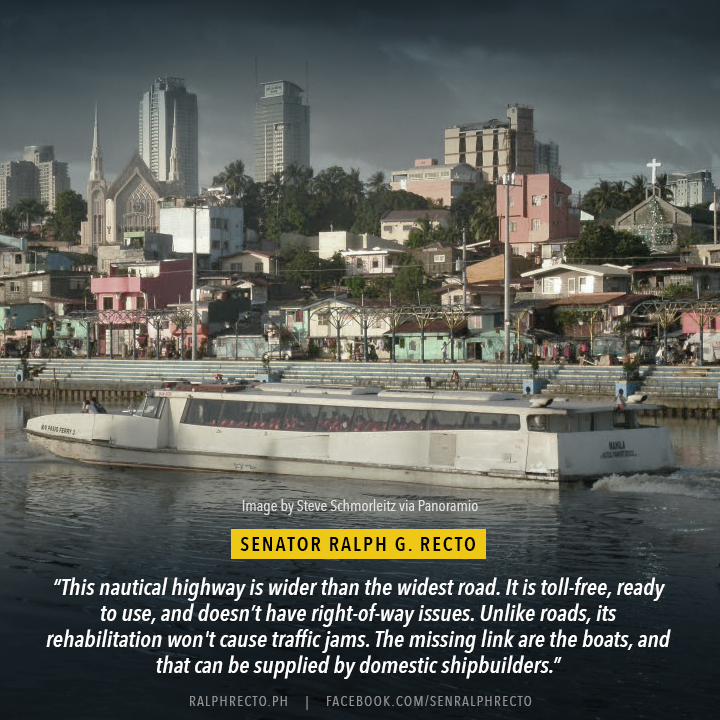If we can buy P18 B ships, we can afford PH-made Pasig River ferry boats, hospital ships, coastal patrols
For a fraction of the P18 billion price tag of two Navy frigates, the country can buy locally-made Pasig River ferry boats, floating hospitals, environmental patrol boats, and other ships needed by a disaster-prone archipelago where half of the towns lie along the coast.
The call was made by Senate President Pro Tempore Ralph Recto who said that the deficit in ships is not only in the Navy, but also in civilian activities such as coast guard patrol, calamity response and tapping Manila’s main waterway as an alternative to its car-choked streets.
“If we were able to find the means to buy our Navy more ships, then we should also be that resourceful in meeting the needs of other agencies for more floating assets,” Recto said.
And in acquiring these ships, the government can “buy Filipino” by tapping the vibrant shipbuilding industry in President Duterte’s home province of Cebu, as well as Navotas and Subic, where Duterte last month led the launch of a half-kilometer-long megaship which can carry 20,950 40-foot container vans.
He also cited the two Navotas-made research ships commissioned by the Bureau of Fisheries and Aquatic Resources—the Lapu-Lapu and Francisco Dagohoy—which have been on research and enforcement patrol since their launch two years ago.
“P250 million lang ang halaga ng bawat isa. Katumbas lang ng downpayment natin doon sa mga Dalian trains ng MRT na hindi naman nagagamit,” Recto said.
Recto said the Philippines has been recognized as the fourth largest shipbuilder in the world. “If other nations find our ships exceptional, then we should, too.”
He said local shipbuilders can build the “country’s humanitarian fleet.”
“We need a hospital ship. Kahit maliit lang. Or two all-purpose mercy ships which can be used as floating headquarters when all land structures have been destroyed. We are an archipelago. And when there’s a typhoon and the roads are destroyed, the only way to reach the victims is by sea,” he said.
“At kung mga barko lang for coastal or river patrol, then our local shipyards make them. The weaponry can come from abroad pero siguro yung barko pwede na dito. How can we keep our rivers and seas clean when our ecological police cannot set out to sea for lack of boats?” he said.
Recto said government should also reach out to local shipbuilders “in optimizing the unused resource that is the Pasig River in solving Manila’s traffic.”
One of the solutions, Recto said, “is that body of water in between the President’s office in Malacañang and the President’s bedroom in Bahay Pangarap. He can see and smell the solution.”
Recto said the cost of reviving Pasig River as a people mover is less compared to the expensive land-based solutions like trains and elevated expressways.
“This nautical highway is wider than the widest road. It is toll-free, ready to use, and doesn’t have right-of-way issues. Unlike roads, its rehabilitation won’t cause traffic jams. The missing link are the boats, and that can be supplied by domestic shipbuilders,” Recto said.
Before the 10-boat Pasig River ferry service stopped operations in 2011, it served 17 stations along a 15-kilometer route from Plaza Mexico in Intramuros, Manila to Nagpayong in Pasig City.


